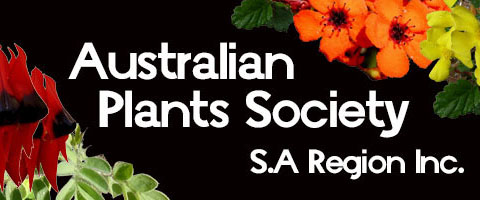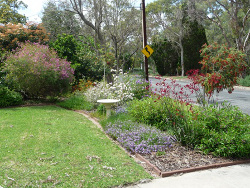Attracting Native Birds to Your Garden Using Native Plants
There are many native plants which will attract native birds to your garden or rural property.
Nectar producing plants like Banksias, Grevilleas, Hakeas, Callistemons and Eucalypts readily spring to mind. However there are a wider range of plants which should be included in your plantings to provide 'habitat' e.g. perching, shelter and security as well as many plants which provide seed for seed eating birds, and insects for the insect eating birds. Different birds inhabit and feed in the different 'layers' of a garden, the treetops, the understorey and the ground, so providing them with this varied habitat is very important.
Many nectar producing plants and habitat plants will also attract insects which are eaten by nectar feeding birds as well as other birds. Lerps are a common insect on Eucalypts over summer, and their sugary coating provides an excellent food source for birds like New Holland Honey Eaters at a time when nectar producing flowers may be scarce.
Many plants are often ignored for attracting birds, for example Acacias (wattles) are very important for shelter, perching, insect attraction and seed production . Crested pigeons have been observed nesting in Acacia cardiophylla, while other birds like the rufous whistler and grey shrike-thrush seem to enjoy this same plant for daytime perching and shelter. Acacia ligulata seems a very desirable plant to many birds like white winged trillers, thornbills, silvereyes, wrens and singing honey eaters.
Don't forget the bark dwelling birds like tree creepers and sitellas and currawongs and other birds who feed on the many insects living in the bark, particularly of Eucalypts. Don't be in too great a hurry to cut down that dead tree as tree creepers seem to enjoy the insects revealed as the bark peels back, and you'll notice that many birds prefer perching on dead branches, where they have a clearer entry and exit than on foliaged branches.
Now for some lists of plants suitable for attracting native birds. Choice of species will be dictated by soil type, rainfall, aspect and size of plant. Another factor to consider is flowering time e.g. Correas flower mainly in autumn and winter. Careful selection of Banksias and Grevilleas will give flowering all year.
NECTAR PRODUCING
Banksias, Hakeas, Callistemons, Grevilleas, Melaleucas, Calothamnus, Anigozanthos, Correas, Eucalypts and Eremophilas.
SEED PRODUCING
Banksia and Hakea seeds attracts yellow tailed black cockatoos if you live in the Adelaide Hills or Southern Fleurieu. Banksia marginata, B. ornata and Hakea rostrata, H. rugosa, H. carinata and H. mitchellii are some of the species found naturally in those areas. Allocasuarina verticillata seed is enjoyed by glossy black cockatoos on Kangaroo Island and is widespread throughout SA.
Many native grasses such as Austrodanthonia, Austrostipa and Themeda attract rosellas and cockatoos as well as finches. Acacia seed can also be an important food source.
GALL PRODUCING
Though not that desirable on plants galls do attract galahs and rosellas who tear open the seed to eat the insect causing the gall. Galls appear on many Acacia and Eucalypt species.
HABITAT PLANTS
Prickly plants like some of the Grevilleas and Hakeas are good plants for security from predators. Outstanding ones include Grevillea 'Pryors'Hybrid', G. 'Glen Sandra', G. 'Canberra Gem' and G. 'Clearview David'.
Hakea nitida and H. verrucosa are good as are Banksia aculeata and Dryandra praemorsa, all from WA. Acacia paradoxa and A. rupicola are excellent, and grow naturally in many areas of SA, while Acacia victoriae is very good in the drier areas of SA.
NESTING AND PERCHING
Many Acacias, Eucalypts, Hakeas, Grevilleas, Melaleucas and Callitris are useful for nesting and perching.
NESTING BOXES
These are useful in many gardens, even where there are mature trees, as hollows take many, many years to form. See the FauNature web site for more information.
ARTIFICIAL FEEDING AND WATERING
Avoid artificial feeding if possible in favour of sustainable feeding by using plants.
Birdbaths should be kept clean and topped up regularly with fresh water, particularly in summer. They should also be placed near shrubs and trees with good perching positions for the birds to escape to if predators are about.
PLANTING A NEW GARDEN
When planting a new garden consider using some plants which will very quickly attract nectar feeding birds as these birds will also significantly reduce insect damage to all your plants while they mature. So incorporate ground cover Grevilleas and Correas and clumping plants like Anigozanthos (kangaroo paws) which will quickly produce numerous flowers.
Remember to plan your 'layers', trees, shrubs, groundcovers and grasses to provide different birds with their different requirements.
SUMMARY
Attracting birds to your garden will give you immense pleasure with their presence to observe their behavior and marvel at their antics. Another great advantage is their presence will reduce the need to use harmful insecticides and pesticides. They will also pollinate many of your plants.
OTHER REFERENCES
Use APS Query to see what plants are suitable to your conditions attract birds.
Good books include "Grow What Where", by N. Peate, G. MacDonald and A. Talbot, "The Australian Bird Garden", by Graham Pizzey, "Attracting Birds to your Garden in Australia" by John Dengate, "Birdscaping your Garden", by George Adams and "Habitat Garden, attracting wildlife to your garden", by Peter Grant.




